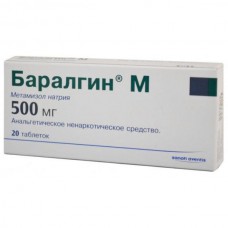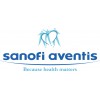Expiration date: 08/2026
Structure and Composition:
1 ml solution for injection contains 500 mg of sodium metamizol in 5 ml ampoules, box 5 vials.
1 tablet - 500 mg in a blister pack of 10 pieces, in a box of 10 blisters..
Pharmachologic effect:
Blocks cyclooxygenase and reduces the synthesis of GHGs.
Pharmacokinetics:
After oral administration in the gastrointestinal tract is hydrolyzed to form the active metabolite - metilaminoantipirina-4 (4-MMA), which is absorbed in the liver at the 4-aminoantipyrine (4-AA) and pharmacologically inactive metabolites. After oral administration of 1 g of 58% metamizol 4 48% MMA and 4-AA bound to plasma proteins. An effective therapeutic concentration in 4-MMA plasma levels achieved after 20-40 min, Cmax - 2 hours.
Testimony:
The pain of mild to moderate intensity syndrome (headache, toothache, neuralgia, pain with radiculitis, osteochondrosis, arthritis, menalgii), smooth muscle spasms (renal colic, biliary colic, intestinal colic), feverish conditions in infectious and inflammatory diseases (in a combination therapy).
Contraindications:
Hypersensitivity to pyrazolone (including metamizolizopropilaminofenazonu, propyphenazone and fenazonsoderzhaschim means, phenylbutazone). Acute hepatic porphyria, congenital deficiency of glucose? 6-phosphate dehydrogenase.
Application of pregnancy and breastfeeding:
It contraindicated in I and III trimesters of pregnancy. Application in II trimester - only under strict medical indications. Breast-feeding is contraindicated within 48 hours after receiving baralgin M.
Side effect:
Agranulocytosis, leukopenia, thrombocytopenia, a sharp drop in blood pressure, transient renal dysfunction (oliguria or anuria, proteinuria), interstitial nephritis, allergic and immunopathological reactions (urticaria rashes on the skin, conjunctiva, the mucous membranes in the nose and throat of Stevens-Johnson syndrome, Lyell's syndrome, anaphylactic shock).
Drug Interactions:
It reduces the concentration of the cephalosporin in the blood, increases the effect of alcohol.
Dosage and administration:
In / in, in / m. For adults and adolescents over 15 years of single dose of 2-5 ml (w / or w / o), the daily dose - up to 10 ml. B / in a single dose exceeding 2 ml (1 g), is possible only after careful setting indications. For children and infants the daily dose is set taking into account body weight (5-8 kg infants - 0.1-0.2 ml / m children 9-15 kg - 0.2-0.5 mL / O or / children 16-23 kg m - 0.3-0.8 mL / w or w / o children 24-30 kg - 0.4-1 ml / v or w / o 31-45 kg - 0.5 1.5 mL / or / 46-53 kg m -. 0.8-1.8 ml / v or w / o B / drug administration should be done slowly (1 ml for 1 minute) in the position of a patient lying down and under the control of blood pressure, heart rate and respiration. The injection solution should be body temperature.
Inside, adults - 500-1000 mg 4 times a day. The maximum single dose - 1 g daily - 3 years
Precautionary measures:
It should be particularly careful with arterial hypotension (systolic blood pressure below 100 mm Hg) in situations characterized by instability indicators of systemic hemodynamics (acute myocardial infarction, multiple trauma, starting shock) in patients with a history of violations of peripheral blood (eg, treated with cytostatic agents) or hypersensitivity reactions to drugs (food preservatives, fur, hair dye), suffering from bronchial asthma and / or chronic infectious-inflammatory respiratory tract diseases with hypersensitivity to any of NSAIDs and analgesics, antipyretics (threat the development of asthma and shock) in infants of the first 3 months of life or weighing less than 5 kg (increased risk of renal dysfunction). Do not combine with drugs that cause intolerance reactions (X-ray contrast agents, plasma substituting solutions, penicillins). The sudden worsening of the patient's general condition (fever, inflammation of the oral mucous membranes of the nose and throat, increased erythrocyte sedimentation rate), you must immediately stop taking. In the case of anaphylactic shock is required to enter in / (slowly) 0.1% epinephrine solution (if necessary - again with intervals of 15-30 min), then - a glucocorticoid, antihistamines, hold replacement of blood volume, ventilation, cardiac massage.
Special instructions:
You can not mix in the same syringe with other. Drugs. Excretion in the urine of one of the biotransformation products can cause red coloration of urine (clinical significance and does not disappear after the cancellation).




